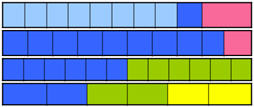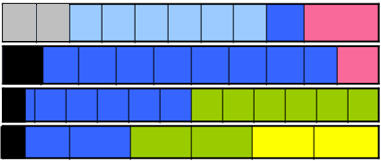The diagram below shows the structure of the degree programmes in the Department of Computing Science at the University of Glasgow. We have a four-year Honours degree, with the first two years also covering subjects other than computing science. Students decide at the end of second year which Honours programme they will follow – we may therefore lose students to other subjects at this point. Once a student has decided to do Computing Science in third year (“Junior Honours”), they stay with us through fourth year (“Senior Honours”) until they graduate.
HCI teaching through the curriculum With respect to HCI, there is a clear ‘vertical curriculum’, with some HCI being offered in all four years. In years one to three, the HCI material is mandatory; the Senior Honours and MSc students may or may not take elective HCI courses.
Course coverage
Vertical vs Horizontal Curriculum Review This HCI vertical curriculum is seldom addressed as a whole. Annual rolling reviews of our programmes are typically done at the year level (horizontal) rather than by topic (vertical). Like our other vertical curricula (databases, systems, programming and development), the HCI curriculm is seldom reviewed as a whole to ensure each course builds on what has come before. What do I do? It is accident (rather than design) that I have been given both the first and second year HCI courses to teach – this therefore presents an opportunity to consider this vertical curriculum and ensure students experience ‘joined-up’ courses that recognise what has come before in the previous year. In the past, I have also taught the optional HCI course in the MSc programmes (“User Centred System Design”).
In this portfolio, I will refer mainly to the first year five-week Human Computer Interaction course, although some examples will be taken from the HCI component of the second year Information Management course.
Departmental perspective on teaching In a highly research-intensive department such as ours, there is little overt acknowledgement of innovative teaching methods, and, while there is some collaboration and communication between the academic staff as to ways to enhance our teaching, it is infrequent. We have a Teaching Committee that rules on departmental policies and procedures (e.g. the maximum time students should wait before getting feedback on their assignments; processes for dealing with mitigating circumstances), but this committee does not address the quality of our educational provision, ways of engaging students, innovative assessment etc. Some procedures (both at departmental and university level) may even stifle such innovation: for example, limits to examination duration, limits to the proportion of marks that can be awarded for coursework, assignment to lecture theatres without movable furniture, acceptable types of assessment, minimum requirements for credit etc. There are people in the department who research innovative educational methods (and sometimes even publish in this area), but such innovation and research output is not always valued as highly as ‘real’ computer science research.
|

